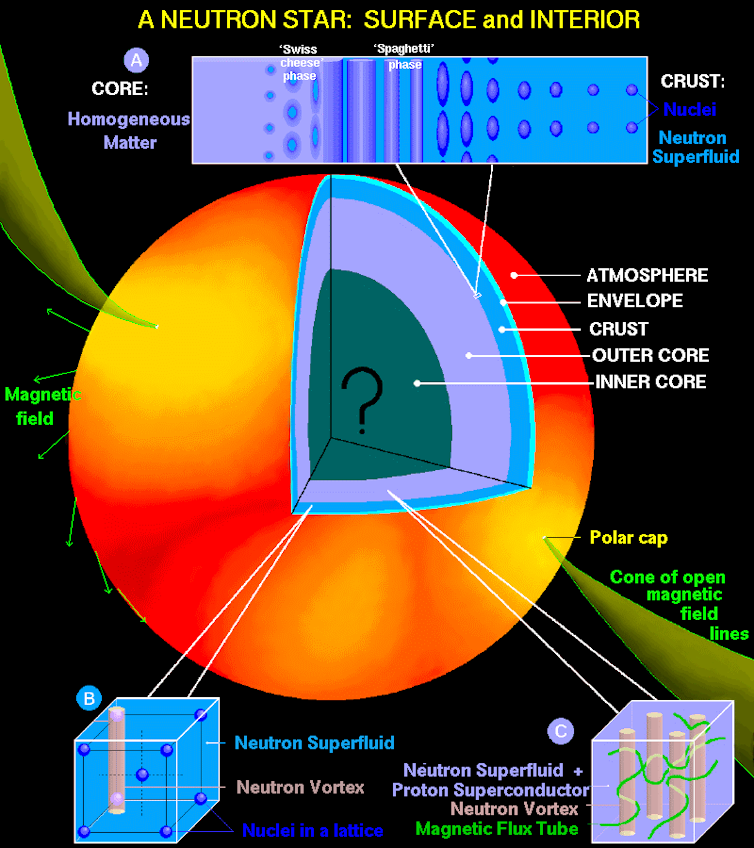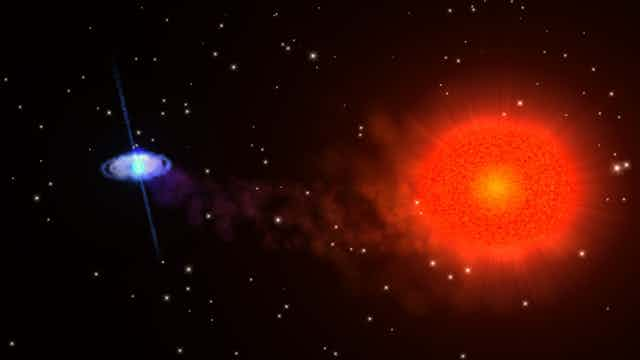Neutron stars are arguably the most exotic objects in the universe. Like one of those annoying friends who seemingly must overachieve in every aspect of life, neutron stars exceed in almost every category: surface gravity; magnetic field strength; density; and temperature.
“But wait,” I hear you say, “black holes are much denser!” In one sense that’s true, but we can’t actually determine the interior structure of a black hole, as it’s forever hidden behind the event horizon.
Neutron stars, with a solid crust (and even oceans and an atmosphere!) are the densest solid object we can observe, reaching a few times the density of an atomic nucleus at their core. A sample of neutron star material the size of a grain of sand would weigh roughly the same as the largest ship ever to sail the seas – more than 500,000 tonnes.
Neutron stars also offer a wealth of extreme behaviour which makes them a compelling target for astrophysicists. For the public, however, they seem to suffer from an image problem, lacking the visual appeal of objects that we can image directly, or the otherworldly weirdness of black holes.
Origin of a neutron star
Neutron stars are thought to be formed from the supernova explosion that ends the life of a medium-sized star, roughly eight to 20 times the mass of our sun. Once its nuclear fuel is consumed, the star explodes, losing most of its material into space.
What’s left collapses into a tiny object (by astronomical standards) around 22km across, the size of a large city, but still about one-and-a-half times the mass of our sun.
While the crust is composed mainly of crystalline iron, such atoms cannot survive deeper in the star, and the material transitions via a bizarre “nuclear pasta” phase (region A in the image, below) into the neutron fluid of the core (regions B and C).
The conditions in the core cannot be reproduced in any terrestrial experiments, and the uncertainty about this region – perhaps comprising exotic hyperons or even “strange quark matter” – is a prime motivator for studying these objects.

Neutron stars give off little visible light, making them practically impossible to detect in blind searches. Most of the few-thousand known examples have been discovered instead via their radio pulsations.
Like cosmic lighthouses, the paired radio beams from these pulsars sweep out across the universe. If the beam crosses the Earth, they may be detected with ground-based radio telescopes such as the Dish at Parkes, New South Wales. The nearest pulsar, PSR J0437-4715 is about 500 light-years away.
Of course, there are many more examples with beams that don’t reach the Earth, so the observed sample is a small fraction of the total galactic population. As well as these ordinary radio pulsars, there are several other more interesting flavours, also with rather quirky names:
- Rotating RAdio Transients (RRATs) are pulsars with (apparently!) wonky beams that flicker on and off
- magnetars are pulsars with incredibly strong magnetic fields
- microquasars are pulsars with jets reaching relativistic speeds
All in a spin
Typical pulsating neutron stars spin about once per second, which is remarkably fast for such a massive, dense object. But if the star happens to have a normal binary companion (see top image) the neutron star can “spin up” to more than ten times the speed of a typical washing machine on the spin cycle.
The process by which this occurs is called accretion. Over the thousand-million year lifetimes of these objects, the companion star evolves (and expands) until the outer layers feel the gravitational pull of the neutron star.
Gas from the companion star can then flow onto the neutron star, spinning it up, the same way that you can spin a free bicycle wheel with the stream from a garden hose.
This process has some remarkable side effects. The gas falling onto the neutron star is heated to tens of millions of degrees, and the neutron star will begin to shine brightly, in X-rays rather than radio waves. Such radiation is blocked by the Earth’s atmosphere, but can be detected by satellite-based telescopes like those operated by NASA and the European Space Agency (ESA).
In fact, the brightest object in the X-ray sky, apart from the sun, is a likely neutron star, Scorpius X-1 (the first X-ray source discovered in the constellation of Scorpius), which orbits it’s mass donor companion once every 19 hours.
Fusion occurs
The gas which collects on the surface of the neutron star via the accretion process is likely similar to the composition of our own sun – primarily hydrogen and helium, with a few per cent of other elements.
The neutron star’s enormous gravity – a few hundred billion times stronger than Earth’s – will compress and heat the gas, leading after a few hours or days to the point at which nuclear fusion can occur.
But this burning isn’t as well-behaved as in stars like the sun. Instead, the burning is unstable, and proceeds in just a few seconds to completely engulf the neutron star’s surface, exhausting all the accumulated fuel and giving rise to an X-ray burst visible across the galaxy.
These bursts have been observed in about 100 systems since the first X-ray telescopes were launched in the 1960s. Occurring once every few hours to days (depending upon the accretion rate), they are by far the most frequent thermonuclear explosions in the universe.
Of course, the supply of gas from the companion will eventually run out. And when that occurs, the neutron star may reprise it’s role as a radio pulsar, although now spinning hundreds of times every second. The current record-holder PSR J1748-2446ad spins 716 times every second!
But even neutron stars cannot remain active forever. Ultimately the spin energy will dissipate and without a companion to recycle it, the pulsar will cross the death line beyond which it is no longer detectable.
After that, the neutron star will gradually cool until the end of time. Until then, neutron stars will continue to serve as extraordinary laboratories for the study of matter under extreme densities and temperatures.

